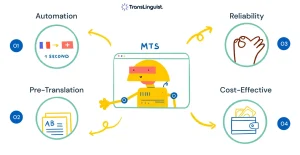How to Integrate Machine Translation into Your Workflow
Adding machine translation (MT) to your translation process can save time, reduce costs, and get multilingual content out faster. But without a plan, basic machine translation can be a disaster and inconsistent. At TransLinguist we believe a considered and structured approach to adding MT can transform your global communication. Here’s a step-by-step guide to help you add MT to your workflow.
1. Understanding Machine Translation
Machine translation is a groundbreaking technology that enables computers to translate text from one language to another. By leveraging machine learning algorithms and statistical models, machine translation systems can analyze the structure and syntax of languages, producing translations that often rival those of human translators. This technology has gained significant traction in recent years due to its ability to quickly and cost-effectively translate large volumes of text.
There are several types of machine translation, each with its unique approach:
- Rule-based Machine Translation: This method relies on pre-defined linguistic rules and dictionaries to translate text. While it can be effective for specific language pairs, it often struggles with idiomatic expressions and complex sentence structures.
- Statistical Machine Translation: Utilizing machine learning algorithms, this approach analyzes vast datasets of existing human translations to generate translations. It identifies patterns and correlations within the data, allowing it to produce more accurate translations over time.
- Neural Machine Translation (NMT): The most advanced form, NMT uses artificial intelligence to learn the intricacies of languages. By mimicking the human brain’s neural networks, NMT can generate translations that are more fluent and natural-sounding, making it the preferred choice for many businesses today.
Understanding these different types of machine translation helps in selecting the right technology for your specific needs, ensuring you get the best possible translation quality.
1. Set Your Translation Goals
Before you start with machine translation it’s essential to set your goals. Machine translation development has significantly evolved, incorporating rule-based, statistical, and neural machine translation to enhance language processing. What do you want to achieve with MT? Do you want to reduce costs, speed up turnaround times or localize more content? By setting clear goals you can make informed decisions about when and where to use MT in your process. If you want to check the pros and cons of machine translation you can refer to The Benefits and Limitations of Machine Translation for Businesses
For example, if cost reduction is your priority then raw MT might be fine for internal documentation. But if brand tone and accuracy are critical like for customer-facing content then a hybrid approach combining MT with human post editing might be required. Setting your goals ensures you align machine translation technology usage with your overall business strategy.
2. Analyse and Categorise Your Content
Not all content requires the same level of translation quality. Categorizing your content based on visibility, audience, importance, and target language is key to adding MT effectively. At TransLinguist we recommend categorizing your content into the following types:
- High visibility content: Customer-facing content such as marketing campaigns, product descriptions, and websites. These should be human translated with MT playing a supporting role through post editing.
- Internal content: Manuals, internal reports, and documentation that may only require raw MT or light post editing to be clear.
- Temporary content: Content like social media posts or customer reviews may require rapid MT with minimal post editing to get it out fast without compromising too much on quality.
This categorization helps you apply the right amount of translation effort to each content type to get the best of both worlds.
Choose the Right Language Pairs for Your Target Language
The right machine translation software depends heavily on your language pairs. Different MT engines are better at certain languages than others. For example, NMT engines are often better at widely spoken languages like English, Spanish, and French while less common languages may require more specialist solutions.
Think about the availability of training data for your language pairs. MT engines learn from large datasets so languages with lots of data like Chinese or Japanese tend to perform better. Evaluating your language needs helps you choose the right engine that gives accurate translations and reduces the need for heavy post-editing.
5. Benefits of Machine Translation
Machine translation offers a multitude of benefits that can revolutionize your translation process. One of the most significant advantages is the increased speed and efficiency it brings. With machine translation, businesses can swiftly translate large volumes of text, eliminating the bottlenecks associated with manual translation. This is particularly beneficial for companies operating in multiple languages, as it enables them to communicate with global customers and partners more effectively.
Another key benefit is the improved accuracy of translations. Machine translation systems, especially those using neural machine translation, leverage machine learning algorithms to analyze extensive datasets of human translations. This allows them to learn the nuances and structures of languages, resulting in translations that are more precise and natural-sounding.
Cost savings are also a major advantage. By reducing the reliance on human translators, businesses can significantly cut down on translation expenses. This is especially useful for companies that need to translate large volumes of text regularly, as it helps to streamline operations and improve overall efficiency.
In summary, machine translation can enhance your translation process by offering speed, accuracy, and cost-effectiveness, making it an invaluable tool for businesses looking to expand their global reach.
Add Machine Translation Technology to Your Workflow with a Plan
Having a plan for how a machine translation service will fit into your translation process is key. At TransLinguist we recommend outlining a detailed workflow that includes MT at the right stages:
- Pre-translation: Use MT for initial translations of high-volume content. This will give you a basic understanding of the content before human translators refine it.
- Post editing: Implement machine translation post-editing (MTPE) where human translators review and correct MT output. This will ensure the final translation is accurate, culturally relevant, and on-brand voice.
- Continuous improvement: Monitor and evaluate your MT results regularly and adjust your process as needed. This could be retraining the MT engine with your own domain-specific data to improve the output over time.
By deciding when and how to use MT you can simplify your translation process and still have control over quality and consistency.
Choose Your Neural Machine Translation Provider
Choosing the right machine translation provider is key to your strategy. Evaluating the best machine translation software is crucial to ensure you select the right option based on your specific needs. There are many providers out there like Google Translate, Amazon Translate, Microsoft Translator, and DeepL each with their own strengths depending on your needs.
- Google Translate: General purpose, supports many languages
- Amazon Translate: Known for its integration with AWS and good performance in certain languages like Chinese.
- DeepL: Often praised for delivering more natural-sounding translations, especially for European languages.
Test providers by running test translations and gathering feedback from your translators. Automated scoring methods like BLEU and TER can also help you measure translation quality. Also, consider the privacy policies if your content contains sensitive information.
Or contact TransLinguist for machine translation services tailored to your business needs. Our solutions are designed to fit into your workflow and deliver high-quality translations fast and efficiently. Whether you need raw MT, light post editing, or full post editing our team will make sure you get the most out of machine translation.
Machine Translation Post Editing for Translation Quality
Machine translation post-editing (MTPE) is a crucial part of your MT strategy. It combines the speed of MT with the expertise of a human translator. Depending on the content and its importance you can choose:
- Light post-editing: Correcting only essential errors for internal or less critical content where readability is the main goal.
- Full post-editing: Ensuring complete accuracy, fluency, and cultural relevance for customer-facing content.
At TransLinguist we recommend tailoring your post editing efforts to your content priority and business goals. Post-editing allows you to have quality while leveraging the speed of MT so it’s a flexible solution for all your translation needs.
9. Common Use Cases for Machine Translation
Machine translation is versatile and can be applied in various scenarios to meet different business needs. One of the most common use cases is website translation. By using machine translation, businesses can quickly and easily translate their websites into multiple languages, ensuring they can reach a broader audience. This is particularly advantageous for companies operating in multiple countries, as it allows them to provide localized content that resonates with their target audience.
Document translation is another prevalent use case. Businesses often need to translate large volumes of text, such as contracts, agreements, and technical manuals. Machine translation can expedite this process, making it more efficient and cost-effective. This is especially beneficial for companies that deal with extensive documentation regularly, as it helps to maintain consistency and accuracy across all translated materials.
Customer support is also a significant area where machine translation can make a difference. By enabling businesses to communicate with customers in multiple languages, machine translation enhances the customer support experience. This is crucial for companies with a global customer base, as it allows them to provide timely and effective support, improving overall customer satisfaction.
Incorporating machine translation into these common use cases can help businesses streamline their operations, reduce costs, and enhance their global communication efforts.
7. Monitor and Measure
Once you have MT in your workflow continuous monitoring and evaluation are key to long-term success. Track key metrics like translation accuracy, turnaround time, and cost savings to measure your strategy.
Update your training data and adjust your process based on feedback from your translators and performance metrics. This way your machine translation will evolve with your business needs and quality will be high and inefficiencies low.
Conclusion
Machine translation in your workflow requires a thoughtful approach, balancing speed and cost with accuracy and cultural relevance. Follow these steps and refine your process and you’ll get the most out of machine translation.
Contact TransLinguist to get tailored MT solutions for your business. Our machine translation services will simplify your workflow, save you costs, and maintain quality. Whether you need to streamline your internal processes or go global our expertise will make sure your machine translation delivers results. Use TransLinguist for all your machine translation and take your multilingual content to the next level.



